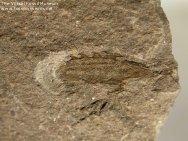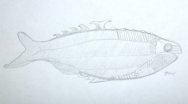Birkenia
elegans
Phylum Chordata;
Subphylum Vertebrata; Superclass Agnatha; Class Anaspida
Geological
Time: Upper Silurian
Size: 15
mm long
Fossil Site:
Seggholm, Muikirk, Ayrshire, Scotland
|  The
Anaspids were simple dorso-laterally compressed fish that probably
led a bottom-dwelling existence. Their main common feature was a
jawless mouth. Indeed the name means without jaws. They were mostly
quite small fishes that flourished during the Silurain and Devonian
that then became extinct except for their modern day relatives the
Lampreys and The
Anaspids were simple dorso-laterally compressed fish that probably
led a bottom-dwelling existence. Their main common feature was a
jawless mouth. Indeed the name means without jaws. They were mostly
quite small fishes that flourished during the Silurain and Devonian
that then became extinct except for their modern day relatives the
Lampreys and  Hagfishes.
The gills opened as a row of holes along the side of the animal,
typically numbering from 6-15. One unusual example from Canada holds
the record for gills at 30 pairs! They probably behaved much like
the lampreys, and most lived in freshwater environments. This fine
example is known as Birkenia. It had an elaborate array of dorsal
scales, some of which are seen here. Indeed, these alone would be
sufficient to identify this specimen. Hagfishes.
The gills opened as a row of holes along the side of the animal,
typically numbering from 6-15. One unusual example from Canada holds
the record for gills at 30 pairs! They probably behaved much like
the lampreys, and most lived in freshwater environments. This fine
example is known as Birkenia. It had an elaborate array of dorsal
scales, some of which are seen here. Indeed, these alone would be
sufficient to identify this specimen.
|
|